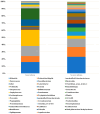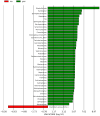Butyrate Producers in Very Low Birth Weight Infants with Neither Culture-Proven Sepsis nor Necrotizing Enterocolitis
- PMID: 40284194
- PMCID: PMC12029688
- DOI: 10.3390/nu17081329
Butyrate Producers in Very Low Birth Weight Infants with Neither Culture-Proven Sepsis nor Necrotizing Enterocolitis
Abstract
Background/Objectives: Severe infection (sInfection; either late-onset culture-proven sepsis or necrotizing enterocolitis) in very low birth weight (VLBW) infants increases mortality rates and may show long-term progression. The fecal microbiome composition in VLBW infants with and without sInfection was classified in the sInfection and non-sInfection groups. Methods: Gut microbiomes, secondary information from a previous randomized trial, were analyzed using QIIME 2 software. The biodiversity and abundance of the gut microbiota between the sInfection and non-sInfection groups were compared. Results: Fifty-one neonates were included in the sInfection (n = 9) and non-sInfection (n = 42) groups; no significant differences in the fecal microbiome were observed in both alpha and beta diversities. Analysis of relative abundance revealed that in both groups, the predominant gut microbiota phylum, class, and genus were Proteobacteria, Gammaproteobacteria, and Klebsiella, respectively. The main fecal microbiome in the non-sInfection group included Faecalibacterium, Clostridium butyricum, and Bacteroides fragilis. Clostridium_sensu_stricto _1 was significantly more abundant in the non-sInfection group than in the sInfection group. Conclusions: Clostridium_sensu_stricto_1 was the main gut microbiota in the non-sInfection group. Considering the potential taxa as synbiotics (correlations among prebiotics, probiotics, and postbiotics), therapeutics may be useful for preventing and managing necrotizing enterocolitis or late-onset culture-proven sepsis in VLBW infants.
Keywords: biodiversity; butyrate producers; gut microbiome; microbiota; necrotizing enterocolitis; neonatal sepsis; nutrigenomics; premature infant.
Conflict of interest statement
The authors declare no conflicts of interest.
Figures



Similar articles
-
The Microbiome and Metabolome of Preterm Infant Stool Are Personalized and Not Driven by Health Outcomes, Including Necrotizing Enterocolitis and Late-Onset Sepsis.mSphere. 2018 Jun 6;3(3):e00104-18. doi: 10.1128/mSphere.00104-18. Print 2018 Jun 27. mSphere. 2018. PMID: 29875143 Free PMC article.
-
S100A8 and S100A9 Are Important for Postnatal Development of Gut Microbiota and Immune System in Mice and Infants.Gastroenterology. 2020 Dec;159(6):2130-2145.e5. doi: 10.1053/j.gastro.2020.08.019. Epub 2020 Aug 15. Gastroenterology. 2020. PMID: 32805279
-
Unraveling the Microbiome of Necrotizing Enterocolitis: Insights in Novel Microbial and Metabolomic Biomarkers.Microbiol Spectr. 2021 Oct 31;9(2):e0117621. doi: 10.1128/Spectrum.01176-21. Epub 2021 Oct 27. Microbiol Spectr. 2021. PMID: 34704805 Free PMC article.
-
The potential of gut microbiota and fecal volatile organic compounds analysis as early diagnostic biomarker for necrotizing enterocolitis and sepsis in preterm infants.Expert Rev Gastroenterol Hepatol. 2018 May;12(5):457-470. doi: 10.1080/17474124.2018.1446826. Epub 2018 Mar 6. Expert Rev Gastroenterol Hepatol. 2018. PMID: 29488419 Review.
-
Necrotizing Enterocolitis, Gut Microbiota, and Brain Development: Role of the Brain-Gut Axis.Neonatology. 2019;115(4):423-431. doi: 10.1159/000497420. Epub 2019 Apr 11. Neonatology. 2019. PMID: 30974443 Free PMC article. Review.
References
-
- Thatrimontrichai A., Chanvitan P., Janjindamai W., Dissaneevate S., Jefferies A., Shah V. Trends in neonatal sepsis in a neonatal intensive care unit in Thailand before and after construction of a new facility. Asian Biomed. 2014;8:771–778. doi: 10.5372/1905-7415.0806.356. - DOI
-
- Gerios L., Rodrigues V.H.B., Corrente J.E., Lyra J.C., Rugolo L., Bentlin M.R. Late-onset sepsis in very low birth weight premature infants: A 10-year review of a Brazilian tertiary university hospital-the challenge remains. Am. J. Perinatol. 2024;41:e1725–e1731. doi: 10.1055/s-0043-1768702. - DOI - PubMed
-
- Stoll B.J., Hansen N., Fanaroff A.A., Wright L.L., Carlo W.A., Ehrenkranz R.A., Lemons J.A., Donovan E.F., Stark A.R., Tyson J.E., et al. Late-onset sepsis in very low birth weight neonates: The experience of the NICHD Neonatal Research Network. Pediatrics. 2002;110:285–291. doi: 10.1542/peds.110.2.285. - DOI - PubMed
MeSH terms
Substances
Grants and funding
LinkOut - more resources
Full Text Sources
Medical

